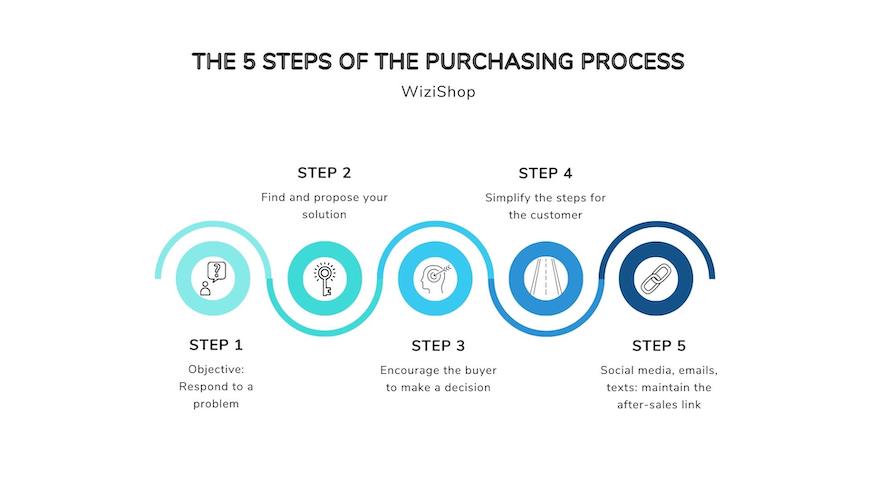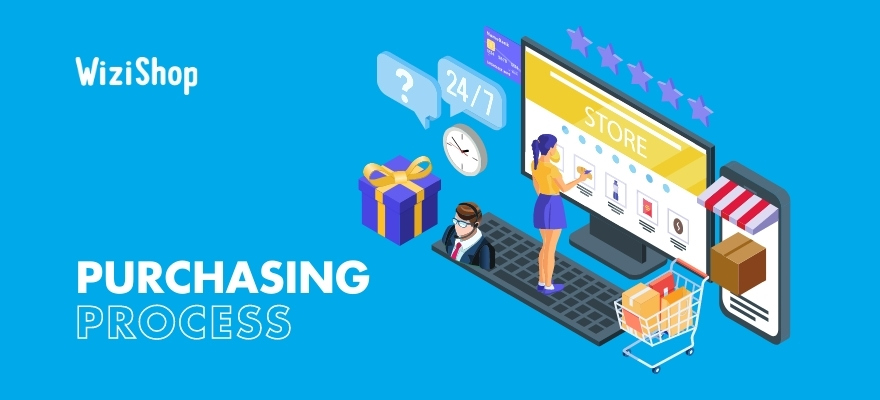During your journey as an e-merchant, your objective will be to offer the best service to your buyers and to constantly find solutions to keep your customers loyal to you. This is especially important if your business is based in a competitive market.
The management of your website will be facilitated if you set up a sales strategy adapted to your customers and if your company’s buyers have a say: thanks to an evaluation of your ecommerce site by them, you’ll always be able to move forward on the right path by minimizing the risks of making mistakes.
Discover the 5 key steps of your purchasing process and all our tips.
What is the purchasing process: definition
The purchasing process is defined as a set of actions necessary for the internet user to buy a product or a service from a seller or a service provider. Although organizations may sell different goods or services, the purchasing processes experienced by their customers will likely be similar.
The consumer's journey before the act of purchase
Before the act of purchase, the consumer determines their need, consciously or not. The need may be created following the discovery of a product, resulting in a compulsive purchase for example, or it may be necessary to the consumer's life.
The process for the marketer begins at this moment, and the challenge will be to entice the prospect so that they can choose to buy the product or service.
During the product sales cycle
The purchasing process also develops during the product sales cycle: once the product has been discovered and the interest of the potential buyer has been established, the path towards the purchase takes shape.
To achieve a positive outcome, the sales cycle must be smooth (fluid navigation, addition of information, simple payment platform, etc.).
In addition, data such as delivery times, product quality, commercial relationship, and comments on review sites are all elements that will influence the sales cycle.
What are the post-sale marketing levers?
The purchasing process doesn’t end once the user has validated their order: when the buyer receives their package and after delivery, post-sale marketing levers will be crucial for customer loyalty.
Email marketing, solicitation of the buyer to share their feedback on their ecommerce customer experience, etc.: the after-sales phase is central to the success of the business. The after-sales phase is key to perfecting your customer experience and making you a true professional.
What are the main steps in the purchasing process?
Discover the 5 basic and essential steps of the act of purchasing to complete your journey and help increase your conversion rate.
1. Objective: respond to a problem
This step can also be considered as the "need recognition" process. The consumer notices a lack, a need, and analyzes this stage while getting ready to look for a solution, to complete the act of buying. At this point, the prospect will move on to the information search phase.
The prospect's research will then be based on several criteria. Their comparative study will examine the items they’ll need in relation to their objective. Then, they’ll turn to the best suppliers/vendors (based on the reviews, the quality proposed, their budget, etc.) in order to have a good understanding of the market.
For example: an internet user wants to start gardening to build their terrace. They therefore need a supply of goods to achieve their goal. They go on the internet to know which products will be suitable, view the costs of the goods, and determine the best sellers.
2. Find and propose your solution
As an online sales professional, your job is to answer the "invitations to tender" of the buyers on the web. Prospects have precise specifications that will help them to reach their goals.
On the e-tailer's side, in order for the interested prospect to make purchases from their sales site, a contract of trust will have to be symbolically "signed": the value proposition made by the professional must tip the balance in their favor.
For example: the customer has compared offers and is hesitating between two competitive sales sites with many similarities.
3. Encourage the buyer to make a decision
What’s your company’s main quality? What’s your added value? What would drive the consumer to shop on your website and spend their hard-earned money? Analyze your ecommerce business and determine the strategic axis you want to give to your online store based on the target audience.
Because ecommerce companies cannot live without customers, your target is the key to your business: this will determine the types of purchases you can offer as well as the entire organization of your company.
It’s then time to incite, to attract, and to set up purchase scenarios that’ll then meet the consumer's specifications, while signing this famous contract of trust between you.
These elements of reassurance must be present on your site and your social networks for example. Financial security, data protection, positive reviews, clear and modern branding... All the signals that will allow the consumer to imagine purchasing from your store and that will help you stand out from other companies in your competitive field will all be beneficial for your ecommerce business.
An example: a customer will be more inclined to purchase goods from Seller A than from Seller B based on the fact that there is a greater number of positive reviews, the business is geared towards eco-responsibility and offers more attractive services, and the goods are made locally, even if the products cost the same or are even slightly higher.
4. Simplify the steps for the customer
Now that your company has passed the customer's invitation to tender, the buyer's analysis will focus on the form, on the website, and the services of the partner/vendor.
Is the arrival on the website, the first step of the process, smooth? Is the navigation fast? Is it easy to contact your customer service team or in-store salespeople if the visitor wants to request help? Is it possible to save your selection in a wishlist to be able to find the products later for future orders? Does your ecommerce software allow you to offer several ways to pay for purchases? Is the shipping cost clear? Are the terms for returning orders clear?
The entire "user experience" part will be decisive for potential buyers who must then take a position and be sure of their decisions. This is when the number of shopping cart abandonments is likely to rise: if the pages before the payment require users to fill in too much information or if the shipping costs are too high, for example, buyers will opt to spend their money elsewhere, placing their orders with retailers they’d previously discovered.
Example: the consumer can easily navigate on your mobile site, view the price and other relevant details for the goods you sell in less than three clicks, and without registering, they’re able to place their order with payment via Paypal and enjoy no-cost delivery in a relay point, right next to their office.
5. Social media, emails, texts: maintain the after-sales link
Although the purchasing process makes people think that it ends once the purchase is made, this definition isn’t quite true: the purchasing process also continues after the sale, as in "preparation" for future orders.
After the sale, a large part of the process will be linked to the purchase that has just been made by the buyer. The e-merchant can solicit the user by sending an email or a text message, by sending a message on their social networks, or by adding a kind note in their package. The seller will thus be able to maintain the link with the customer after the transaction and encourage them to share their opinion on the internet in order to indicate if their experience has met all their requirements.
Once this "feedback" step is over, the perfect recipe must be found, with finesse, to really hold on to the link with the satisfied buyer: this is called loyalty. Suggesting similar or complementary products to their previous order, automatic reminders after a certain time if the product needs to be recommended after a specific time, newsletters with tips related to the products you sell and which could be of interest to the customer segment in which the buyer is...
Your organization must make itself indispensable to the consumer. But be careful: it’s not a question of spamming your customer but of becoming an aid, an ally!

How do you determine the purchasing process on your site?
Now that we’ve seen the heart of the purchasing process and each key step involved, how will it take shape on your ecommerce site?
How do you create a good purchasing process for your target?
The first thing to keep in mind for the majority of your company’s ecommerce processes, including in terms of where you decide to spend your budget for various actions, is your target: who is your customer, what type of individual do you want to reach, what is their typical profile?
The persona is going to be the key to your global strategy, and this will go through all aspects of your business. Sales, SEO, marketing, offers, supplier choice, etc. All your activity is linked to the consumer who will keep your business alive: make them the focus of all your steps!
How do you efficiently manage the purchasing process in an ecommerce company?
Your customers will be the central pillar of your organization’s buying process: they’ll give you the steps to follow but also their opinion after having tested and approved your activity.
Email forms, social network surveys, and the monitoring of loyalty markers will be useful to help improve and develop your company’s offer.
Thanks to the WiziShop ecommerce solution, you’ll be able to give voice to your customers quickly and in a few clicks. By automating your personalized emails and texts and by proposing cross-selling actions, high-quality services, promotions, and flash offers, you can be sure to reach your target and encourage them to stay with you for the long haul.
The purchasing process: a story of target, trust, and commitment to your buyers, for a win-win relationship.
Try WiziShop free for 7 days
THE EASIEST NO-CODE ECOMMERCE SOLUTION✅ No credit card required
✅ Access to all features
✅ No commitment










